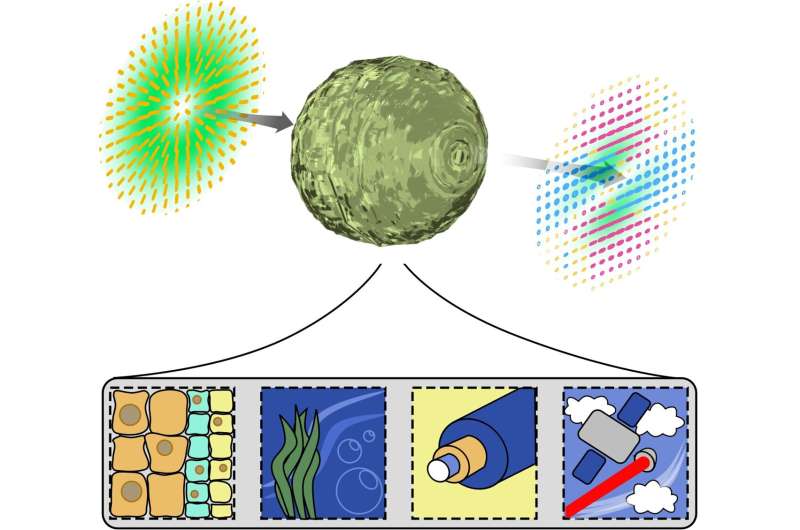An artistic impression of complex vectorial light passing through some distorting complex media and becoming altered in some way. The pattern of the light depicts the polarization state. The complex media shown in the insets includes living tissue, under-water, optical fiber and transmission through the atmosphere. Credit: Wits University
A team led by researchers at the University of the Witwatersrand in Johannesburg, South Africa, with collaborators from the University of Pretoria (South Africa), as well as Mexico and Scotland, have made a new discovery on how light behaves in complex media, media that tends to distort light significantly. They demonstrated that "distortion" is a matter of perspective, outlining a simple rule that applies to all light and a vast array of media, including underwater, optical fiber, transmission in the atmosphere and even through living biological samples.
Their novel quantum approach to the problem resolves a standing debate on whether some forms of light are robust or not, correcting some misconceptions in the community. Importantly, the work outlines that all light has a property that remains unchanged, an insight that holds the key to unraveling the rest of the perceived distortion. To validate the finding, the team showed robust transport through otherwise highly distorting systems, using the outcome for error-free communication through noisy channels.
Nature Photonics today published online the research by the team led by Professor Andrew Forbes from the School of Physics at Wits University. In their paper the team explain the simple rules that govern complex light propagation in complex media. Firstly, they find that all such media can be treated in the same way, and that the analysis does not depend on the type of light used. Previously each choice of media and light beam were treated as a special case, not so any longer—the new general theory covers it all. Secondly, they show that despite the distortion, there is a property of the light—its "vectorness"—that remains unchanged, invariant to the media. This is always true and had not been noticed before. It holds the key exploiting light even under non-ideal conditions.
If you pass light through an imperfect medium, such as the atmosphere, it gets distorted. For instance, the shimmering mirage effect near hot roads or the twinkling of stars are both examples of light that becomes distorted, because of the atmosphere's turbulence. Light can also sometimes be deliberately distorted, like the mirrors at a fun fair that make you look taller, thinner or rounder. In this case we all understand that the distortion is just a matter of perspective—a quick glance at ourselves without the mirror reveals the reality—but is this also true in other distorting systems? Is there a way to look at the light so that the distortion disappears? The Wits led team show that yes, some properties are never distorted, while others can be unraveled by a change of perspective.
The question is how to understand what happens to the light, how it is distorted, and how to find the new perspective? To answer these questions the team used the most general form of light possible, vectorial light. Light has an electric field whose direction can vary across the field, sometimes points upwards, downwards, left, right, and so on. A light's "vectorness" is how mixed up the direction of the electric field of a light is. In other words, it is a measure of how similar the directions of the electric fields of a light are at different places: if it is the same everywhere (homogenous) the value is 0, and if it is everywhere different (inhomogeneous) the value is 1. This vectorial homogeneity never changes, even if the pattern of the electric field itself changes. The reason is embedded in quantum entangled states, a topic that appears to have little in common with optical distortions. The new discovery was made possible by applying tools from the quantum world to the world of optical distortions.
"What we've found is that the vectorness is the single attribute of light that does not alter when passing through any complex media," says Professor Andrew Forbes, from the Wits School of Physics. "This means we have something special that can be exploited when using light for communications or sensing."
"This is a particular aspect of the pattern of the light—how the polarization pattern looks," says Forbes. "The 'polarization' is just a fancy way to describe the direction of the electric field that makes up light. The pattern is also distorted, but its intrinsic nature (of homogenous or inhomogenous) is not."
The team's approach allows researchers to identify how to correct any distortions through the media in a way that doesn't cost any light. In other words, there is no loss.
"We show that even though the light is very distorted, the distortion is only a matter of perspective. One can view the light in such a way that it regains its original 'undistorted' properties. It is remarkable that complex light in complex media can be universally understood from very simple rules."
For instance, by just changing how a measurement is made, any communications through a very distorted media can be made "distortion free". This the team showed was true experimentally through a range of systems, from turbulence, to liquid or optical fiber.
More information: Isaac Nape et al, Revealing the invariance of vectorial structured light in complex media, Nature Photonics (2022). DOI: 10.1038/s41566-022-01023-w
Journal information: Nature Photonics
Provided by Wits University
























